
 Anmelden
Anmelden
Michael Hieslmair/ Michael Zinganel
Ein Beitrag für B1|A40 Die Schönheit der großen Strasse
Bochum, 2010
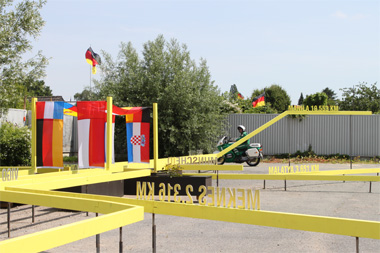
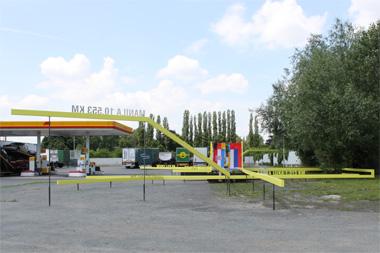
Tankstellen-Urbanismus
Im Netzwerk des globalen Waren- und Güterverkehrs nimmt das Ruhrgebiet seit jeher eine zentrale Stellung ein. Das Labyrinth an Autobahnen bestimmt und vernetzt den äußerst dicht besiedelten polyzentrischen, urbanen Großraum. War das dichte Netz aus Verkehrswegen in der Nachkriegszeit noch ganz nach dem modernistischen Diktum der Funktionstrennung angelegt worden, so begannen sich spätestens seit den Wirtschaftswunder-Jahren die räumlichen Nutzungszuschreibungen immer mehr zu mischen und zu überlagern. Während die industrielle Produktion sukzessive in den Hintergrund gedrängt wird steigt parallel dazu der Bedarf an Distributions- und Logistikzentren an. Daher stellt dieses Labyrinth die alltägliche Arbeits- und Lebenswelt von Pendlern und Berufsfahrern dar, für die sich Autobahnraststätten und Tankstellen immer mehr zum Ersatz für soziale Knotenpunkte und Nahversorgungszentren entwickeln. Selbst für die angrenzende Schrebergartenanlage hat die Tankstelle als rund um die Uhr geöffneter Gemischtwaren-Laden eine wichtige Funktion.
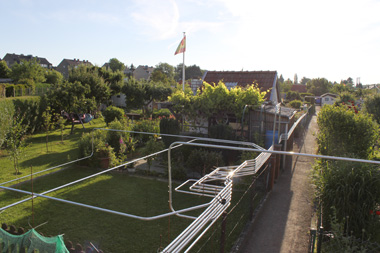
Der Fokus der Arbeit lag daher zuerst auf der Raststätte Wattenscheid als transnationalem Kreuzungspunkt, an dem Haltepunkt sich anhand von ausgewählten Akteuren und den von ihnen zurückgelegten Wege Rückschlüsse auf globale Transformationsprozesse und den regionalen Strukturwandel ziehen lassen.
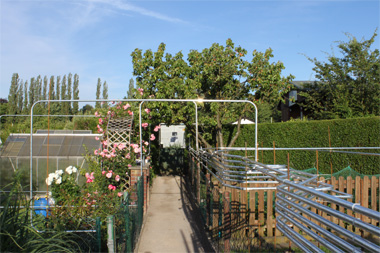
Internationale Kleingarten-Gemeinschaft
Bei den Vorrecherchen fiel die unmittelbar an die Raststätte angrenzende Kleingarten-Anlage auf, deren Flaggen über die Lärmschutzwand ragen und von der Autobahn aus sichtbar sind. Diese Flaggen zeigen keineswegs ein homogenes Bild, z.B. ausschließlich aus Flaggen der Kleingartenbewegung, Deutschen National Flaggen und Flaggen des bedeutendsten Fußballvereins (Schalke 04), wie das zu erwarten wären – hier finden sich stattdessen Flaggen verschiedenster Bundesländer und Nationen, die auf die unterschiedliche Herkunft der Kleingärtner und Gärtnerinnen verweisen: In diesen Flaggen bilden sich demnach Migrationsgeschichten des Ruhrgebietes ab, u. a. von Gastarbeitern der ersten Generation, die in ihrer Pension ein Stück deutschen Kleingartens erobert haben, oder von jüngeren Zuwanderern, die erfolgreich in einen Kleingarten einheirateten.
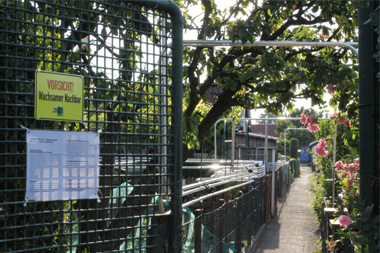
Platzwechsel
Die Ergebnisse der parallel durchgeführten Recherchen zum transnationalen Knotenpunkt Autobahntankstelle sowie zum lokalen Freizeitparadies mit Migrationshintergrund werden in zwei unterschiedliche dreidimensionale Wegenetz- und Audioinstallationen übersetzt. Die Platzierung der beiden Netzwerke erfolgt dabei am jeweils anderen Ort: Auf dem Parkplatz der Raststätte werden die Migrationswege der Kleingärtner nachgestellt, in zwei benachbarten Kleingärten jenseits der Lärmschutzwand das Netzwerk typischer Stammkunden der Autobahntankstelle an der A40.
Standort Parkplatz der Raststätte
Genaue Ortsangaben (siehe oben)
Die Recherchen über 8 Akteure aus der Kleingartensiedlung werden in einer Wegenetz-Installation und über Hörstationen präsentiert. Jedem der Akteure ist in horizontaler Ebene die stark abstrahiert „Spur“ seiner geographischen Migrationsgeschichte – von Ausgangspunkt seiner Reise bis in den Kleingartenparzelle – zugeordnet. Die Spur besteht aus miteinander verbundenen über dem Boden schwebenden lackierten Holzbalken, auf denen Name des Herkunftsortes angebracht.
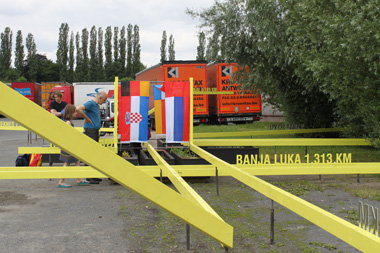
Die 8 Wege laufen auf einen gemeinsamen Kreuzungspunkt zu, der mit 8 Hochbeeten einen fiktiven Ausschnitt der Kleingartenanlage markiert. Im Bereich der Hochbeete knicken die Wege rechtwinkelig nach oben, so dass sie gemeinsam die Umriss-Linie einer archetypischen Hausform bilden, in die die Nationalflaggen der Herkunftsnationen eingehängt sind. Jedes Hochbeet ist einem Akteur zugeordnet, dieses wird in Absprache entsprechend seiner/ihrer Vorlieben bepflanzt. Gleichzeitig ist in jedes Hochbeet ein Lautsprecher eingebaut. An diesen Hörstationen können die Besucher vor Sonneneinstrahlung geschützt auf den Holzrosten Platz nehmen und den von NachrichtensprecherInnen wie Verkehrsmeldungen gesprochenen Audiospuren von individuellen Migrationsgeschichten zuhören.
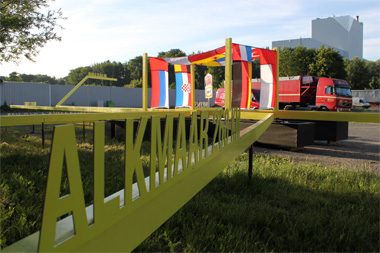
Tonspuren – Wegenetz am Parkplatz der Raststätte
Lailani 72., Rentnerin
„Lailani kam 1970 mit bereits 32 Jahren im Rahmen eines Anwerbe-Programms für Krankenschwestern und Pflegepersonal aus dem 10.553 km entfernten Manila nach Deutschland. Zuvor besuchte sie auf den Philippinen an einer privaten Schule …“Wolfgang 62., Rentner
„Wolfgang ist 1948 in Deutschland geboren, er wuchs in Munscheid auf, nur 8 km vom Kleingartenverein entfernt. Mit 14 Jahren begann eine Lehre …“
Jamal 36., Kontrolleur
„Jamal kam am 18. November 1986 im Alter von 12 Jahren mit seiner Mutter und sechs Geschwistern aus dem 2.316 KM entfernten MEKNÈS nach Düsseldorf. Sein Vater, ein gelernter Mauer, lebte dort bereits seit Jahren, nachdem er in den 1970er Jahren in Marokko …“
Miguel 64., Rentner
„Miguel kam 1971 aus Vigo, einer 2.112 km von der Gartenanlage entfernten Hafen- und Industriestadt im äußersten Nordwesten Spaniens nach Deutschland. Aufgrund eines Arbeitsabkommens zwischen der Franco Diktatur und Deutschland warben …“
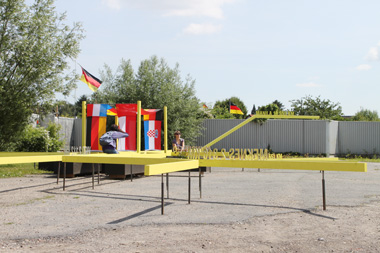
Joep 60., Rentner
„Joep kam über Christian, einen deutschen Freund, im März 1990 im Alter von 50 Jahren nach Wattenscheid. Die beiden hatten sich in den Niederlanden kennengelernt,…“
Ayse 63., Rentnerin
„Ayse kam am 5. Oktober 1972 mit 25 Jahren erstmals nach Deutschland. Ihr Ehemann konnte sich noch im Rahmen des Anwerbeabkommen bei deutschen Behörden in der Türkei bewerben bevor …“
Dunja 52., Reinigungskraft
„Dunja kam am 27. Juni 1979 aus dem 1.313 km entfernten Banja Luka nach Deutschland, einer mittelgroßen Stadt im ehemaligen Jugoslawien. Banja Luka liegt in Bosnien Herzegowina und ist die Hauptstadt der neuen von Serben dominierten Republika Srpska,…“
Bozena 42., Altenpflegerin
„Bozena kam am Donnerstag, den 23. März 1989 im Alter von 21 Jahren nach Deutschland. Sie ist in Zabrze bzw. auf Deutsch „Hindenburg“ aufgewachsen,…“
Standort Kleingartenanlage
Genaue Ortsangaben (siehe oben)
Die an der Autobahntankstelle durchgeführten Recherchen werden in eine zweite mit Hörstationen ausgestattete Wegenetz-Installtion übersetzt. Die Wege der 12 Akteure erstrecken sich dabei über mehrere Kleingarten-Parzellen. Die „Spur“ jedes Akteurs kennzeichnet den zurückgelegten Weg in Abhängigkeit zur Autobahntankstelle.
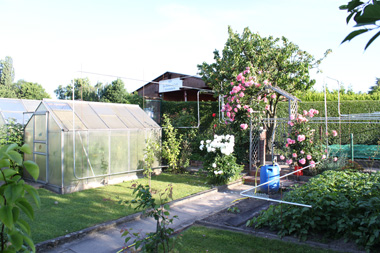
Die Wege bestehen aus blanken Aluminiumrohren, die sich teils gebogen entlang von Zäunen, Gartenlauben, durch Hecken, usw. schlängeln. Am Ende der Wege sind die Herkunfts- und Zieldestinationen der Akteure in Form von Schriftzügen angebracht.
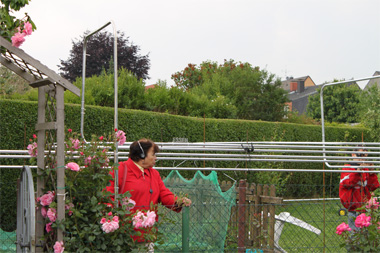
Tonspuren – Wegenetz in der Kleingartenanlage
Ann E. 34., Tankstellenpächterin
Wetter/ Ruhr – Tankstelle – Wetter/ Ruhr
„Ann E. fährt jeden Tag um 5 Uhr morgens mit ihrem dunkelblauen VW Golf in der Kaiserstrasse am nördlichen Stadtrand von Wetter an der Ruhr los. Das Wohnhaus der Familie liegt …“
Heinrich F. 52., Fahrer LKW mit Kühlaufbau
Essen – Nordhorn – Coesfeld – Ahaus – Tankstelle – Essen
„Heinrich F. fährt jeden Tag um halb 3 Uhr früh mit seinem PKW von Essen-Huttrop in eine Gewerbezone im Deilbachtal südlich von Essen. Er fährt täglich bis zu 350 km für die Firma Rasting Fleisch und Wurstwaren vom Fleischhof in Essen zu …“
Jan P. 46., Fahrer Autotransporter
Bochum – Tankstelle – Zeebrügge – Bochum
„Jan 46. fährt mehrmals wöchentlich mit seinem Mercedes 1835 Actros mit Kässbohrer Aufbau für Opel dieselbe Route vom Werk in Bochum zum Hafen in Zeebrügge und zurück, dem größten Umschlagplatz von Neuwägen …“
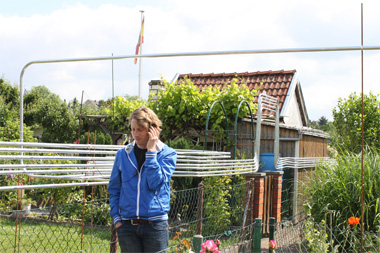
Kryztof W. 51., Fahrer Kleintransporter
Poznan – Lodz – Gdansk – Wrozlaw – Tankstelle – Lille – Basel
„Kryztof W., sein Bruder und zwei Cousins parken mit einem Ford Transit Kastenwagen und einem geleasten M.A.N. 7,5 Tonner am Parkplatz der Raststation. Sie sind am Feiertag nachmittags in Polen los gefahren und warten nun hier …“
Ronny P. 34., Schichtkoordinator und Monteur
Muldental bei Leipzig – Tankstelle – Nordrhein Westfalen/ Sauerland/ Baden
„Ronny P. arbeitet als Schichtkoordinator für ein mittelständisches Unternehmen in Muldental bei Leipzig, dessen Monteure mit 6 Fahrzeugen permanent quer durch ganz Deutschland unterwegs sind. Ronny koordiniert die Aufträge in …“
Wanja K. 39. Fahrer LKW mit Kühlaufbau
Tschernihiw – Kiew – Donezk – Odessa – Tankstelle – Gent – Antwerpen – Rotterdam – Bremen
„Wanja K. lebt in Tschernihiw und fährt für die ukrainische Transportfirma „Translogistika“ einen 40 Tonnen Volvo FH 1242 Sattelzug mit Kühlaufbau durch Europa. Wanja holt in verschiedenen ukrainischen Städten in Kiew, Donezk, oder Odessa …“
Werner H. 43. Außendienstmitarbeiter Firmen-PKW
Lünen – Tankstelle – Düsseldorf
„Werner H. verlässt an Werktagen bereits um 5:30 seine Wohnung in Lünen und startet zu seinem 90km entfernten Arbeitsplatz in einen Düsseldorfer Unternehmen, das Teppichböden vertreibt. Er hängt sein Sakko hinter den Beifahrersitz …“
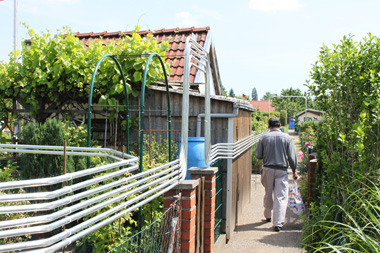
Geöffnet ab Samstag, 12. Juni 2010 ab 14 Uhr (mit Grill)
Offizielle Eröffnung siehe: B1|A40 Die Schönheit der großen Strasse
Ausstellungsdauer: bis Sonntag 8. August 2010
Künstlerführung: Sonntag, 13. Juni um 11 Uhr
Samstag, 7. August 2010 um 16 Uhr
anschließend Abschlussfest im Kleingarten
Treffpunkt bei der Installation auf der Shell-Raststätte „Wattenscheid“
Navigationshilfen zur Anfahrt:
siehe den Eintrag in Google Maps
Anfahrt
Autobahn: A40 Fahrt-Richtung Essen Ausfahrt Shell-Station Eggers GmbH
Vietingstrasse 50
D-44867 Bochum-Wattenscheid
Bundesstrasse aus Bochum oder Wattenscheid: Bochumerstrasse, Abzweigung Vietingstraße
mit Öffentlichen Verkehrsmitteln:
Straßenbahn aus Bochum oder Wattenscheid: Linie 302, Station Vietingstrasse
S-Bahn/ Deutsche Bahn: zu Fuß vom Bhf. Wattenscheid
Kuratiert von MAP, Markus Ambach Projekte
Dank an: Familie Eggers und das Personal der Shell-Station, Rob, Werner, Antonio, Danuta, Richard und die Kleingärtner des Kleingartenvereins „Am Dückerweg“ e.V.
Russischsprachige Recherche: Anna Olshevska
Aufbau: Christian Forsen, Benjamin Hofmann, Lee Taylor
SprecherInnen/ Audio Editing: Solveig Bader, Olaf Biernat, Stefan Leiwen
Fotos: Hieslmair/ Zinganel
CHANGE OF PLACE
As a result observations and interviews with people linked to the station and the allotment gardens, two threedimensional route networks and audio Installations have been developed. They have, however, been positioned at opposite locations, respectively, thus juxtaposing the idyllic privacy and intimacy of the allotments with the stress and noise of the tansport route. Two zones that are, so to speak, simultaneously separated and connected by a "magical" gate in the noise barrier.
AN INTERNATIONAL ALLOTMENT COMMUNITY AT THE AUTOBAHN SERVICE AREA
On the parking lot of the Shell station on the A40, the transport routes of the allotment gardeners are reenacted: each of the eight protagonists is allocated an abstract "trail“, which leads from the starting point of his or her journey to the allotment. The eight routes – suspended wooden beams on which the names of the respective places of origin are mounted – converge upon a common point of intersection. In this fictional extract of the allotment gardens, whIch is covered by a fabric patchwork fashioned from the national flags of the countries of origin, loudspeakers built into eight raised flower beds retell the tales of the protagonist's individual journeys.
Here, for example, visitors can listen to seventy-two-year-old Lailani's experiences of migration. In 1970 at the age of thirty-two, Lailani came to Germany from Manila as part of a recruitment drive for nurses and nursing staff. Or Miguel, aged sixty-four, who was recruited in 1971 as an immigrant worker (Gastarbeiter) in Spain, then still under the dictatorship of Franco; of Ayse, aged sixty-three, who accompanied her husband, a Turkish immigrant worker, to Germany in 1972; of Dunja, aged fifty-two, who arrived from Banja Luka in 1979; of Jamal, aged thirty-six, who, along with his mother and his siblings, joined his father in Germany when he was twelve years old; or of Bozena, aged forty-two, who came from Silesia in 1989 on a tourist visa at the age of twenty-one and decided to stay. The visitor can also learn about the ways in which the immigrants have finally secured their own small allotment plot.
PETROL STATION URBANISM IN THE ALLOTMENT GARDENS
In the allotment gardens Am Dückerweg e.V. beyond the noise barrier, a network of the routes of representative "regulars“, who frequent the Shell station on the A40 is displayed. The installatIon is located along an internal access path, which runs parallel to the highway. The petrol station forms the central junction from which seven routes of selected professional drivers and commuters radiate, reflecting their geographical itineraries on and beyond the A40. Here, the route network consists of twisted aluminium pipes; the individual narratives are relayed via headsets. Visitors can listen to a newsreader narrating, in a factual manner, the respective daily itineraries: Anne E., thirty-four, the station leaseholder; of Werner H., forty-three, who commutes to Düsseldorf every day, and who, Iike many others quickly gulps down a coffee at the service area before being absorbed into the early-morning traffic; Heinrich F., fifty-two, who meets his colleagues at the station every lunchtime after having distributed meat and sausages produced at the Essen slaughterhouse; Ronny P., thirty-four, a mechanic from Leipzig who stops at the station in the afternoon several times a week, in order to take a shower, do his paperwork and spend the night in his bus. Or the stories of Jan P., forty-six, who drives Opel Zafiras from the Bochum works near Dortmund to the Zeebrugge seaport in Belgium; of Kryztof W., fifty-one, a Polish van driver; or of Wanja K., thirty-nine, a truck driver from the Ukraine, who spends his weekends at the station – and who, in some istances is stuck at the service area for days while waiting for a new cargo to arrive.
Formally, the suspended route networks were modeled on the megaconstructions looming above, or even penetrating the cities, which were popularized by the urban utopias of the nineteen-sixties (Friedman, Constant, etc.). Here, however, the networks do not rellect „psycho-geographical“ migrations or visions or utopias or exceptional social conditions, but rather simply portray the everyday life of the workforce in major service sectors: the system of heating-pipes spread across the allotment gardens, like a rhizome, represents a section not only of the technical, but above all of the social inlrastructure of the Ruhr Area and the whole of Europe, where uncountable people from migrant backgrounds – or those with extremely long distances to be covered – go about their business. The sculptur at the petrol station is, for one, simply a seat to be used by travelers on the highway; at the same time however, it is a spatially displaced symbol of an allotment area, whose users are commonly suspected of a certain „immobillty". But here, too, new communities and transnational networks interconnecting local residents and immigrants are emerging.
When the exhibition has ended, the building materials used for the installations will be handed over to the allotment gardeners for reuse: for example, the aluminium pipes make for excellent beanpoles and trestles for espalier fruit; the brightly painted wooden beams will be used for renovating and extending the garden sheds, and the signs on which the names of the gardeners' places of origin are written will be used for decoration. From tha very first day, the gardeners inquired about what would eventually become of „Banja Luka" and all the other signs.
Our gratitude to the Egger family and the staff of the Shell station, Rob, Werner, Antonio, Danuta, Richard and the gardeners of the allotment association Am Dückerweg e.V. Russian-language research: Anna Olshevska; Installation: Christian Forsen, Benjamin Hofmann, Lee Taylor; Narrators/ Audio Editing: SoIveig Bader, Olal Biernat, Stefan Leiwen